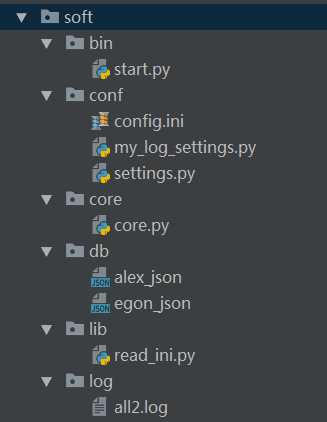标签:功能 exe append 函数名 _for %s bytes 空间 function
常见的场景:一个模块就是一个包含了python定义和声明的文件,文件名就是模块名字加上.py的后缀。
但其实import加载的模块分为四个通用类别:
1. 使用python编写的代码(.py)
2. 已被便以为共享库或DDL的C或者C++扩展
3. 包好一组模块的包
4. 使用C编写并链接到python解释器的内置模块
如果你退出python解释器然后重新进入,那么你之前定义的函数或者变量都将丢失,因此我们通常将程序写到文件中以便永久保存下来,需要时就通过python test.py方式去执行,此时test.py被称为脚本scripts。
随着程序的发展,功能越来越多,为了方便管理,我们通常将程序分为一个个的文件,这样做程序的结构更清晰,方便管理。这时我们不仅可以把这些文件当做脚本去执行,还可以把他们当做模块来导入到其他的模块中,实现了功能的重复利用。
示例文件:自定义模块my_module.py,文件名my_module.py,模块名my_module
#my_module.py print(‘from the my_module.py‘) money=1000 def read1(): print(‘my_module->read1->money‘,money) def read2(): print(‘my_module->read2 calling read1‘) read1() def change(): global money money=0 my_module模块
模块可以包含可执行的语句的函数的定义,这些语句的目的是初始化模块,他们只在模块名第一次遇到导入import语句时才可以执行。(import语句是可以在程序中的任意位置使用的,且针对同一个模块可import很多次,为了防止你重复导入,python的手段是:第一次导入后就将模块名加载到内存了,后续的import语句仅是对已经加载大内存中的模块对象,增加了一次引用,不会重新执行模块内的语句),如下:
#demo.py import my_module #只在第一次导入时才执行my_module.py内代码,此处的显式效果是只打印一次‘from the my_module.py‘,当然其他的顶级代码也都被执行了,只不过没有显示效果. import my_module import my_module import my_module ‘‘‘ 执行结果: from the my_module.py ‘‘‘
我们可以从sys.modules中找到当前已经加载的模块,sys.modules是一个字典,内部包含模块名与模块对象的映射,该字典决定了导入模块时是否需要重新导入。
每个模块都是一个独立的名称空间,定义在这个模块中的函数,把这个模块的名称空间当做全局名称空间,这样我们在编写自己的模块时,就不用担心我们定义在自己模块中全局变量会在被导入时,与使用者的全局变量冲突。
测试一:money与my_module.money不冲突
#测试一:money与my_module.money不冲突 #demo.py import my_module money=10 print(my_module.money)
print(money) ‘‘‘ 执行结果: from the my_module.py
1000
10 ‘‘‘
测试二:read1与my_module.read1不冲突
#demo.py import my_module def read1(): print(‘========‘) my_module.read1() ‘‘‘ 执行结果: from the my_module.py my_module->read1->money 1000 ‘‘‘
测试三:执行my_module.change()操作的全局变量money仍然是my_module中的
#demo.py import my_module money=1 my_module.change() print(money) ‘‘‘ 执行结果: from the my_module.py ‘‘‘
总结: 首次导入模块my_module时会做三件事:
1. 为源文件(my_module模块)创建新的名称空间,在my_module中定义的函数的方法若是使用到了global时访问的就是这个名称空间
2. 在新创建的命名空间中执行模块中包含的代码,见初始导入import my_module
1 提示:导入模块时到底执行了什么? 2 3 In fact function definitions are also ‘statements’ that are ‘executed’; the execution of a module-level function definition enters the function name in the module’s global symbol table. 4 事实上函数定义也是“被执行”的语句,模块级别函数定义的执行将函数名放入模块全局名称空间表,用globals()可以查看
3. 创建名字my_modu来引用该命名空间
1 这个名字和变量名没什么区别,都是‘第一类的’,且使用my_module.名字的方式可以访问my_module.py文件中定义的名字,my_module.名字与test.py中的名字来自两个完全不同的地方。
相当于m1=1,m2=2
1 import my_module as sm 2 print(sm.money)
示例用法一:
有两中sql模块mysql和oracle,根据用户的输入,选择不同的sql功能
#mysql.py def sqlparse(): print(‘from mysql sqlparse‘) #oracle.py def sqlparse(): print(‘from oracle sqlparse‘) #test.py db_type=input(‘>>: ‘) if db_type == ‘mysql‘: import mysql as db elif db_type == ‘oracle‘: import oracle as db db.sqlparse()


#=============>bin目录:存放执行脚本 #start.py import sys,os BASE_DIR=os.path.dirname(os.path.dirname(os.path.abspath(__file__))) sys.path.append(BASE_DIR) from core import core from conf import my_log_settings if __name__ == ‘__main__‘: my_log_settings.load_my_logging_cfg() core.run() #=============>conf目录:存放配置文件 #config.ini [DEFAULT] user_timeout = 1000 [egon] password = 123 money = 10000000 [alex] password = alex3714 money=10000000000 [yuanhao] password = ysb123 money=10 #settings.py import os config_path=r‘%s\%s‘ %(os.path.dirname(os.path.abspath(__file__)),‘config.ini‘) user_timeout=10 user_db_path=r‘%s\%s‘ %(os.path.dirname(os.path.dirname(os.path.abspath(__file__))), ‘db‘) #my_log_settings.py """ logging配置 """ import os import logging.config # 定义三种日志输出格式 开始 standard_format = ‘[%(asctime)s][%(threadName)s:%(thread)d][task_id:%(name)s][%(filename)s:%(lineno)d]‘ ‘[%(levelname)s][%(message)s]‘ #其中name为getlogger指定的名字 simple_format = ‘[%(levelname)s][%(asctime)s][%(filename)s:%(lineno)d]%(message)s‘ id_simple_format = ‘[%(levelname)s][%(asctime)s] %(message)s‘ # 定义日志输出格式 结束 logfile_dir = r‘%s\log‘ %os.path.dirname(os.path.dirname(os.path.abspath(__file__))) # log文件的目录 logfile_name = ‘all2.log‘ # log文件名 # 如果不存在定义的日志目录就创建一个 if not os.path.isdir(logfile_dir): os.mkdir(logfile_dir) # log文件的全路径 logfile_path = os.path.join(logfile_dir, logfile_name) # log配置字典 LOGGING_DIC = { ‘version‘: 1, ‘disable_existing_loggers‘: False, ‘formatters‘: { ‘standard‘: { ‘format‘: standard_format }, ‘simple‘: { ‘format‘: simple_format }, }, ‘filters‘: {}, ‘handlers‘: { #打印到终端的日志 ‘console‘: { ‘level‘: ‘DEBUG‘, ‘class‘: ‘logging.StreamHandler‘, # 打印到屏幕 ‘formatter‘: ‘simple‘ }, #打印到文件的日志,收集info及以上的日志 ‘default‘: { ‘level‘: ‘DEBUG‘, ‘class‘: ‘logging.handlers.RotatingFileHandler‘, # 保存到文件 ‘formatter‘: ‘standard‘, ‘filename‘: logfile_path, # 日志文件 ‘maxBytes‘: 1024*1024*5, # 日志大小 5M ‘backupCount‘: 5, ‘encoding‘: ‘utf-8‘, # 日志文件的编码,再也不用担心中文log乱码了 }, }, ‘loggers‘: { #logging.getLogger(__name__)拿到的logger配置 ‘‘: { ‘handlers‘: [‘default‘, ‘console‘], # 这里把上面定义的两个handler都加上,即log数据既写入文件又打印到屏幕 ‘level‘: ‘DEBUG‘, ‘propagate‘: True, # 向上(更高level的logger)传递 }, }, } def load_my_logging_cfg(): logging.config.dictConfig(LOGGING_DIC) # 导入上面定义的logging配置 logger = logging.getLogger(__name__) # 生成一个log实例 logger.info(‘It works!‘) # 记录该文件的运行状态 if __name__ == ‘__main__‘: load_my_logging_cfg() #=============>core目录:存放核心逻辑 #core.py import logging import time from conf import settings from lib import read_ini config=read_ini.read(settings.config_path) logger=logging.getLogger(__name__) current_user={‘user‘:None,‘login_time‘:None,‘timeout‘:int(settings.user_timeout)} def auth(func): def wrapper(*args,**kwargs): if current_user[‘user‘]: interval=time.time()-current_user[‘login_time‘] if interval < current_user[‘timeout‘]: return func(*args,**kwargs) name = input(‘name>>: ‘) password = input(‘password>>: ‘) if config.has_section(name): if password == config.get(name,‘password‘): logger.info(‘登录成功‘) current_user[‘user‘]=name current_user[‘login_time‘]=time.time() return func(*args,**kwargs) else: logger.error(‘用户名不存在‘) return wrapper @auth def buy(): print(‘buy...‘) @auth def run(): print(‘‘‘ 购物 查看余额 转账 ‘‘‘) while True: choice = input(‘>>: ‘).strip() if not choice:continue if choice == ‘1‘: buy() if __name__ == ‘__main__‘: run() #=============>db目录:存放数据库文件 #alex_json #egon_json #=============>lib目录:存放自定义的模块与包 #read_ini.py import configparser def read(config_file): config=configparser.ConfigParser() config.read(config_file) return config #=============>log目录:存放日志 #all2.log [2017-07-29 00:31:40,272][MainThread:11692][task_id:conf.my_log_settings][my_log_settings.py:75][INFO][It works!] [2017-07-29 00:31:41,789][MainThread:11692][task_id:core.core][core.py:25][ERROR][用户名不存在] [2017-07-29 00:31:46,394][MainThread:12348][task_id:conf.my_log_settings][my_log_settings.py:75][INFO][It works!] [2017-07-29 00:31:47,629][MainThread:12348][task_id:core.core][core.py:25][ERROR][用户名不存在] [2017-07-29 00:31:57,912][MainThread:10528][task_id:conf.my_log_settings][my_log_settings.py:75][INFO][It works!] [2017-07-29 00:32:03,340][MainThread:12744][task_id:conf.my_log_settings][my_log_settings.py:75][INFO][It works!] [2017-07-29 00:32:05,065][MainThread:12916][task_id:conf.my_log_settings][my_log_settings.py:75][INFO][It works!] [2017-07-29 00:32:08,181][MainThread:12916][task_id:core.core][core.py:25][ERROR][用户名不存在] [2017-07-29 00:32:13,638][MainThread:7220][task_id:conf.my_log_settings][my_log_settings.py:75][INFO][It works!] [2017-07-29 00:32:23,005][MainThread:7220][task_id:core.core][core.py:20][INFO][登录成功] [2017-07-29 00:32:40,941][MainThread:7220][task_id:core.core][core.py:20][INFO][登录成功] [2017-07-29 00:32:47,222][MainThread:7220][task_id:core.core][core.py:20][INFO][登录成功] [2017-07-29 00:32:51,949][MainThread:7220][task_id:core.core][core.py:25][ERROR][用户名不存在] [2017-07-29 00:33:00,213][MainThread:7220][task_id:core.core][core.py:20][INFO][登录成功] [2017-07-29 00:33:50,118][MainThread:8500][task_id:conf.my_log_settings][my_log_settings.py:75][INFO][It works!] [2017-07-29 00:33:55,845][MainThread:8500][task_id:core.core][core.py:20][INFO][登录成功] [2017-07-29 00:34:06,837][MainThread:8500][task_id:core.core][core.py:25][ERROR][用户名不存在] [2017-07-29 00:34:09,405][MainThread:8500][task_id:core.core][core.py:25][ERROR][用户名不存在] [2017-07-29 00:34:10,645][MainThread:8500][task_id:core.core][core.py:25][ERROR][用户名不存在]
标签:功能 exe append 函数名 _for %s bytes 空间 function
原文地址:https://www.cnblogs.com/wangph/p/9074922.html